Animal Videos Can Encourage Illegal Trafficking

Nearly everyone loves animal videos and you can see them all over the social networks. However, what seems like an innocent action can actually negatively affect wild animals. This is especially true for a species known as the slow loris.
In 2009, this species began to go viral on the internet. There were videos of slow lorises eating bananas or getting tickled, and these videos spread quickly all over the internet.
The danger of animal videos
While these videos might be cute, it’s important to remember that it’s illegal to have this species of primate as a pet. This is because it is in serious danger of extinction.
A group of researchers decided to analyze the effect of these viral videos on the conservation of the species.
The team analyzed more than 12,000 comments on YouTube. They discovered that, besides many comments about how cute the animal was, there were lots that expressed the desire to have a slow loris as a pet, and there were even questions about where to buy one.
The researchers suggest that this demonstrates a link between viral animal videos and the illegal trafficking of the species. An expert in this species, primatologist Anna Nekaris, says that the species was relatively unknown to the general public until these videos went viral.

The slow lorises that star in these animal videos are illegal pets. They are usually taken directly from their natural habitat, and this is a species that is not typically able to breed in captivity.
In a study, Nekaris and her peers classified the comments on videos into different categories. They also analyzed the impact that celebrities can have on these videos. The most common type of comment was people expressing the desire to own one as a pet.
A change in perception
Fortunately, researchers have also taken advantage of the popularity of these animal videos to publicize the species and its problems. So, in March 2011, a well-known online encyclopedia published information about raising awareness of the illegal slow loris trafficking.
Also, a 2012 documentary brought more attention to the problem. This has led to a wide variety of comments on YouTube. A debate has begun between those who want to protect them, and people who think that these wild animals would be good pets.

The problem with videos of wild animals in humanized environments, as is the case with the slow loris videos, is that they present the idea that these animals would be good pets. It also encourages people to forget that these animals are in danger of extinction.
Misunderstood behavior
In addition, these videos highlight that we don’t fully understand wild animals’ behavior. In the videos of the slow loris, the primate appears raising his arms. To someone not familiar with this species, this seems to be a fun reaction to tickling. In reality, this is most likely a defensive behavior, exposing poisonous glands in the animal.
As a result, an NGO known as International Animal Rescue has created a website known as ‘Tickling is Torture‘, where they report on the problems of the slow loris and illegal trafficking. We hope that viral animal videos don’t end up harming any other wild animals.
All cited sources were thoroughly reviewed by our team to ensure their quality, reliability, currency, and validity. The bibliography of this article was considered reliable and of academic or scientific accuracy.
- Is Social Media Saving or Enslaving the Slow Loris?: Anna Nekaris at TEDxNashville – https://youtu.be/DXvAv-Tacxw
- Nekaris, K. A. I., Musing, L., Vazquez, A. G., & Donati, G. (2016). Is Tickling Torture? Assessing Welfare towards Slow Lorises (Nycticebus spp.) within Web 2.0 Videos. Folia Primatologica. https://doi.org/10.1159/000444231
